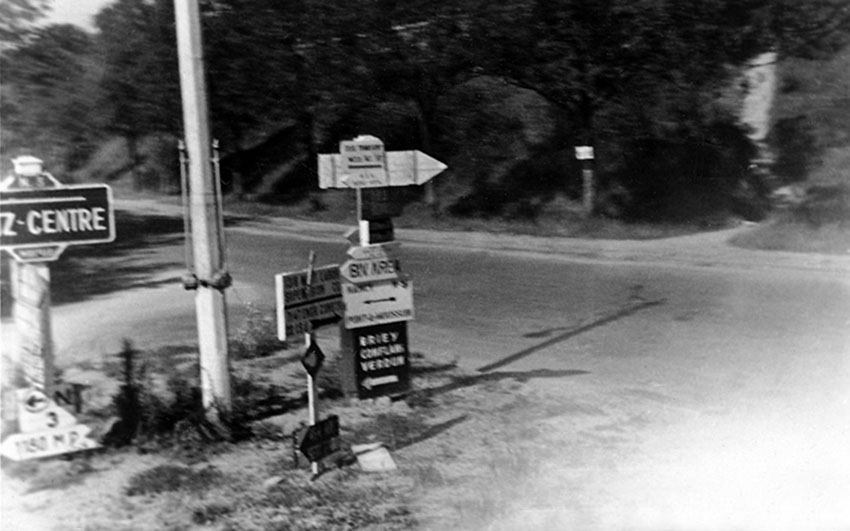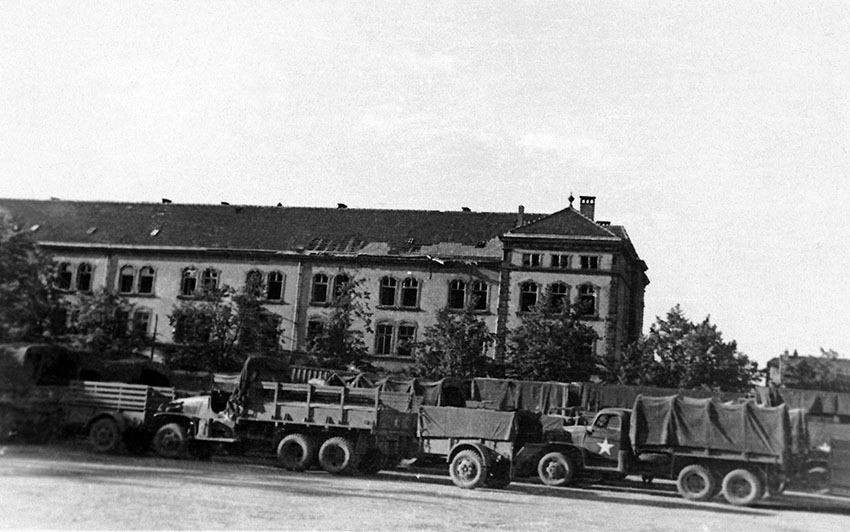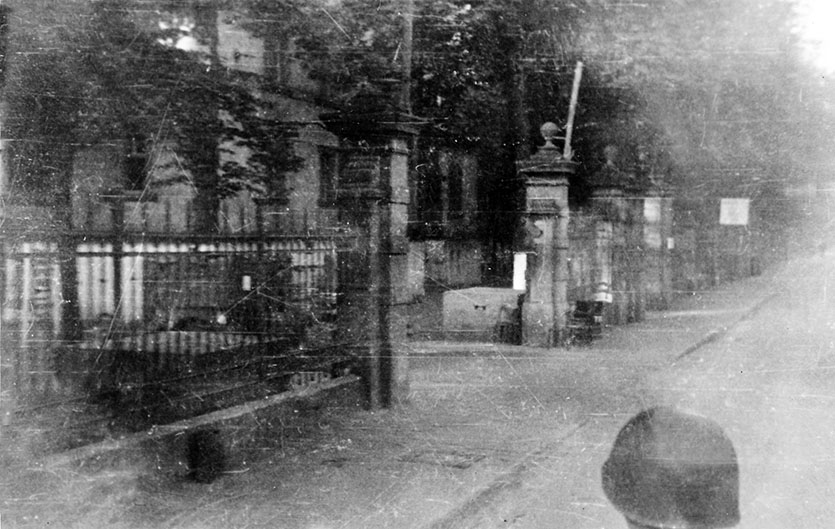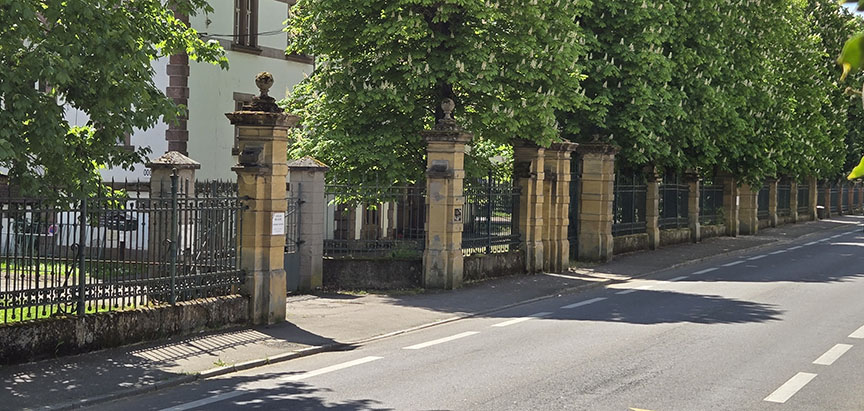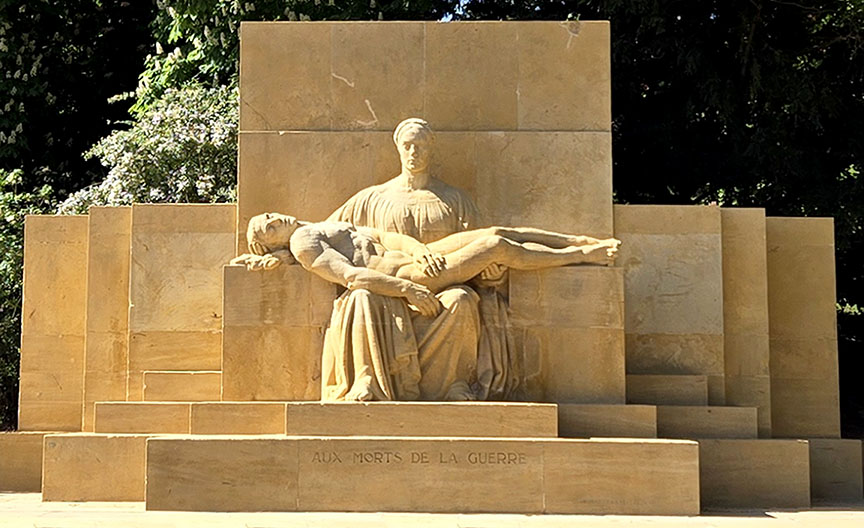- Third U. S. Army After Action Report, Volume I, Chapter 7 – December Operations, Page 153, 154
- Third U.S. Army After Action Report, Volume II, Part 3 – G-2, Page 27
- U. S. Army Heritage and Education Center, U.S. Army Military History Institute 202-244th 1945, “History of The 244th Field Artillery Battalion During World War II, Page 4
- 244th Field Artillery Battalion After Action Report, 1 December to 31 December
- 244th Field Artillery Battalion After Action Report, 1 December to 31 December
- 244th Field Artillery Battalion After Action Report, 1 December to 31 December
- 244th Field Artillery Battalion Journal
- 244th Field Artillery Battalion After Action Report, 1 December to 31 December
- Serving In Harm's Way, A Record of My Service In The U.S. Army and WWII, Byron G. Rogers jr., January 2006
- PFC Harry G. MacDuffee, C Battery, 244th Field Artillery - Battery Record
- 244th F.A. Battalion Battery HQ & Hq Morning Report
- 244th F.A. Battalion Battery B Morning Report
- 244th F.A. Battalion Battery C Morning Report
- 244th F.A. Battalion Battery MD Morning Report
- Library of Congress, American Folklife Center, Veterans History Project
- United States Army In World War II, The European Theater of Operations. The Supreme Command, Forrest C. Pogue, Center Of Military History United States Army, The Green Book
- Third U. S. Army After Action Report, Volume I, Chapter 7 – December Operations, Page 154
- 244th Field Artillery Battalion Journal
- 244th Field Artillery Battalion After Action Report, 1 December to 31 December
- PFC Harry G. MacDuffee, C Battery, 244th Field Artillery - Battery Record
- Third U. S. Army After Action Report, Volume I, Operations, Chapter 7 – December Operations, Page 155
- 244th Field Artillery Battalion After Action Report, 1 December to 31 December
- 244th Field Artillery Battalion Journal
- PFC Harry G. MacDuffee, C Battery, 244th Field Artillery - Battery Record
- 244th F.A. Battalion Battery HQ & Hq Morning Report
- Third U. S. Army After Action Report, Volume I, Operations, Chapter 7 – December Operations, Page 157
- 55th Armored Engineer Bn., 10th Armored Division, After Action Report, November & December 1944, Page 5
- Third U.S. Army After Action Report, Annex No. 2, Third U.S. Army Directives, Page XIX
- 244th Field Artillery Battalion Journal
- 244th F.A. Battalion Battery HQ & Hq Morning Report
- 244th F.A. Battalion Battery A Morning Report
- 244th F.A. Battalion Battery C Morning Report
- 244th F.A. Battalion Battery SB Morning Report
- Third U. S. Army After Action Report, Volume I, Operations, Chapter 7 – December Operations, Page 157
- Field Artillery Support For III Corps Attack 18 – 26 December 1944, Gregory V. Morton paper, Maneuver Center of Excellence Libraries, Donovan Research Library, Fort Benning, Georgia, III Corps, After Action Report, 31 December 44, Page 1
- Field Artillery Support For III Corps Attack 18 – 26 December 1944, Gregory V. Morton paper, Maneuver Center of Excellence Libraries, Donovan Research Library, Fort Benning, Georgia, III Corps, After Action Report
- 244th Field Artillery Battalion Journal
- 244th F.A. Battalion Battery B Morning Report
- USAMHI Archives, Colonel J. Davis Interview
- Third U. S. Army After Action Report, Volume I, Operations, Chapter 7 – December Operations, Page 158
- 244th Field Artillery Battalion After Action Report, 1 December to 31 December
- 244th Field Artillery Battalion Journal
- 244th Field Artillery Battalion After Action Report, 1 December to 31 December
- 244th F.A. Battalion Battery A Morning Report
- 244th F.A. Battalion Battery A Morning Report
- 244th F.A. Battalion Battery C Morning Report
- Third U. S. Army After Action Report, Volume I, Operations, Chapter 7 – December Operations, Page 159
- 244th Field Artillery Battalion After Action Report, 1 December to 31 December
- 244th Field Artillery Battalion Journal
- War Department, Adjutant General’s Office, Headquarters III Corps After Action Report, December 1944, Page 3
- Third U. S. Army After Action Report, Volume I, Operations, Chapter 7 – December Operations, Page 160
- The True Story of The Patton Prayer by Msgr. James H. O'Neill (From the Review of the News 6 October 1971)
- The True Story of The Patton Prayer by Msgr. James H. O'Neill (From the Review of the News 6 October 1971)
- 244th Field Artillery Battalion Journal
- III Corps After Action Report December 1944, 8 December Through 14
December - 244th F.A. Battalion Battery HQ & Hq Morning Report
- 244th F.A. Battalion Battery B Morning Report
- Third U. S. Army After Action Report, Volume I, Operations, Chapter 7 – December Operations, Page 160, 161
- Third U. S. Army After Action Report, Volume I, Operations, Chapter 7 – December Operations, Page 161, 162
- 244th Field Artillery Battalion After Action Report, 1 December to 31 December
- 244th Field Artillery Battalion Journal
- 244th F.A. Battalion Battery A Morning Report
- 244th Field Artillery Battalion Journal
- 244th F.A. Battalion Battery A Morning Report
- Third U. S. Army After Action Report, Volume I, Operations, Chapter 7 – December Operations, Page 162, 163
- 244th Field Artillery Battalion after Action Report, 1 December to 31 December
- 244th Field Artillery Battalion after Action Report, 1 December to 31 December
- Library of Congress, American Folklife Center, Veterans History Project
- 244th Field Artillery Battalion Journal
- PFC Harry G. MacDuffee, C Battery, 244th Field Artillery - Battery Record
- 244th F.A. Battalion Battery A Morning Report
- 244th F.A. Battalion Battery B Morning Report
- Volume I, 3rd Army After Action Report, The Army commander’s Notes on Bastogne Operation, 12 December 1944 to 18 January 1945
- Third U. S. Army After Action Report, Volume I, Operations, Chapter 7, December Operations, Page 163
- 244th Field Artillery Battalion Journal
- 244th F.A. Battalion Battery HQ & Hq Morning Report
- Third U. S. Army After Action Report, Volume I, Operations, Chapter 7, December Operations, Page 164
- War Department, Adjutant General’s Office, Headquarters III Corps After Action Report, December 1944, Page 3
- 244th Field Artillery Battalion after Action Report, 1 December to 31 December
- 244th Field Artillery Battalion Journal
- PFC Harry G. MacDuffee, C Battery, 244th Field Artillery - Battery Record
- 244th F.A. Battalion Battery HQ & Hq Morning Report
- 244th F.A. Battalion Battery A Morning Report
- 244th F.A. Battalion Battery B Morning Report
- 244th F.A. Battalion Battery C Morning Report
- 244th F.A. Battalion Battery SB Morning Report
- 244th F.A. Battalion Battery MD Morning Report
- Third U. S. Army After Action Report, Volume I, Operations, Chapter 7 – December Operations, Page 165
- Department of The Army, USH&EC, USAMHI, 202-244th 1945, “History of The 244th Field Artillery Battalion During World War II
- 244th Field Artillery Battalion after Action Report, 1 December to 31 December
- 244th Field Artillery Battalion Journal
- U. S. Army Heritage and Education Center, U.S. Army Military History Institute 202-244th 1945, “History of The 244th Field Artillery Battalion During World War II, Page 4
- 244th Field Artillery Battalion after Action Report, 1 December to 31 December
- 244th Field Artillery Battalion after Action Report, 1 December to 31 December
- Serving In Harm's Way, A Record of My Service In The U.S. Army and WWII, Byron G. Rogers jr., January 2006
- 244th F.A. Battalion Battery B Morning Report
- Armies Corps Divisions and Separate Brigades, Army Lineage Series, John B. Wilson, Center of Military History, United States Army, Washington, D.C. 1999
- Armies Corps Divisions and Separate Brigades, Army Lineage Series, John B. Wilson, Center of Military History, United States Army, Washington, D.C. 1999
- Armies Corps Divisions and Separate Brigades, Army Lineage Series, John B. Wilson, Center of Military History, United States Army, Washington, D.C. 1999
- Armies Corps Divisions and Separate Brigades, Army Lineage Series, John B. Wilson, Center of Military History, United States Army, Washington, D.C. 1999
- Armies Corps Divisions and Separate Brigades, Army Lineage Series, John B. Wilson, Center of Military History, United States Army, Washington, D.C. 1999
- Third U. S. Army After Action Report, Volume I, Operations, Chapter 7 – December Operations, Page 165, 166
- War Department, Adjutant General’s Office, Headquarters III Corps After Action Report, December 1944, Page 3
- War Department, Adjutant General’s Office, Headquarters III Corps After Action Report, December 1944, Page 4
- Third U. S. Army After Action Report, Volume II, Command – Part 1, Page 6
- 244th Field Artillery Battalion Journal
- 244th Field Artillery Battalion after Action Report, 1 December to 31 December
- 244th Field Artillery Battalion after Action Report, 1 December to 31 December
- Harvey R. Dexter, A Son's Soldier
- Serving In Harm's Way, A Record of My Service In The U.S. Army and WWII, Byron G. Rogers jr., January 2006
- 244th F.A. Battalion Battery B Morning Report
- The U.S. Army Center of Military History, William M. Hammond
- Source Unknown, From Lt. Marriott's WWII Scrapbook
- Volume I, 3rd Army After Action Report, The Army commander’s Notes on Bastogne Operation, 12 December 1944 to 18 January 1945
- Third U. S. Army After Action Report, Volume I, Operations, Chapter 7 – December Operations, Page 166
- War Department, Adjutant General’s Office, Headquarters III Corps After Action Report, December 1944, Page 3
- 244th Field Artillery Battalion Journal
- PFC Harry G. MacDuffee, B Battery, 244th Field Artillery - Battery Record
- 244th F.A. Battalion Battery HQ & Hq Morning Report
- 244th F.A. Battalion Battery "A" Morning Report
- 244th F.A. Battalion Battery B Morning Report
- 244th F.A. Battalion Battery C Morning Report
- 244th F.A. Battalion Battery SB Morning Report
- 244th F.A. Battalion Battery MD Morning Report
- The U.S. Army Campaigns of World War II - Ardennes - Alsace, The U.S. Army Center of Military History, William M. Hammond
- Third U. S. Army After Action Report, Volume I, Operations, Chapter 7 – December Operations, Page 167
- War Department, Adjutant General’s Office, Headquarters III Corps After Action Report, December 1944, Page 6
- 244th Field Artillery Battalion Journal
- 244th Field Artillery Battalion after Action Report, 1 December to 31 December
- 244th Field Artillery Battalion after Action Report, 1 December to 31 December
- W. U. (Doc) Savage Letter, December 15, 1949
- W. U. (Doc) Savage Letter, December 15, 1949
- Department of The Army, USH&EC, USAMHI, 202-244th 1945, “History of The 244th Field Artillery Battalion During World War II
- 244th F.A. Battalion Battery HQ & Hq Morning Report
- 244th F.A. Battalion Battery A Morning Report
- 244th F.A. Battalion Battery B Morning Report
- 244th F.A. Battalion Battery C Morning Report
- 244th F.A. Battalion Battery MD Morning Report
- Volume I, 3rd Army After Action Report, The Army commander’s Notes on Bastogne Operation, 12 December 1944 to 18 January 1945
- Third U. S. Army After Action Report, Volume I, Operations, Chapter 7 – December Operations, Page 168, 169
- War Department, Adjutant General’s Office, Headquarters III Corps After Action Report, December 1944, Page 6
- Third U.S. Army, Notes on Bastogne Operation, G.S. Patton, Jr. Page 2
- 244th Field Artillery Battalion Journal
- HQ Battery, Frederic (Fred) Priewert, 2nd Lt., Journal
- 244th F.A. Battalion Battery SB Morning Report
- Volume I, 3rd Army After Action Report, The Army commander’s Notes on Bastogne Operation, 12 December 1944 to 18 January 1945
- Third U. S. Army After Action Report, Volume I, Operations, Chapter 7 – December Operations, Page 171
- War Department, Adjutant General’s Office, Headquarters III Corps After Action Report, December 1944, Page 8
- War Department, Adjutant General’s Office, Headquarters III Corps After Action Report, December 1944, Page 8
- Armies Corps Divisions and Separate Brigades, Army Lineage Series, John B. Wilson, Center of Military History, United States Army, Washington, D.C. 1999
- Armies Corps Divisions and Separate Brigades, Army Lineage Series, John B. Wilson, Center of Military History, United States Army, Washington, D.C. 1999
- Armies Corps Divisions and Separate Brigades, Army Lineage Series, John B. Wilson, Center of Military History, United States Army, Washington, D.C. 1999
- Department of The Army, USH&EC, USAMHI, 202-244th 1945, “History of The 244th Field Artillery Battalion During World War II
- 244th Field Artillery Battalion after Action Report, 1 December to 31 December
- 244th Field Artillery Battalion Journal
- U.S. Army Military History Institute, Archives Branch, Colonel Davis Papers
- PFC Harry G. MacDuffee, B Battery, 244th Field Artillery - Battery Record
- 244th F.A. Battalion Battery HQ & Hq Morning Report
- 244th F.A. Battalion Battery A Morning Report
- 244th F.A. Battalion Battery C Morning Report
- 244th F.A. Battalion Battery SB Morning Report
- Volume I, 3rd Army After Action Report, The Army commander’s Notes on Bastogne Operation, 12 December 1944 to 18 January 1945
- Third U. S. Army After Action Report, Volume I, Chapter 7 – December Operations, Page 172
- 244th Field Artillery Battalion Journal
- PFC Harry G. MacDuffee, B Battery, 244th Field Artillery - Battery Record
- 244th F.A. Battalion Battery HQ & Hq Morning Report
- 244th F.A. Battalion Battery A Morning Report
- 244th F.A. Battalion Battery B Morning Report
- 244th F.A. Battalion Battery C Morning Report
- 244th F.A. Battalion Battery SB Morning Report
- Volume I, 3rd Army After Action Report, The Army commander’s Notes on Bastogne Operation, 12 December 1944 to 18 January 1945
- Third U. S. Army After Action Report, Volume I. Chapter 7 – December Operations, Page 174
- XII Corps Spearhead of Patton's Third Army, Lt. Col. George Dyer, 1947, Page 286
- 244th Field Artillery Battalion After Action Report, 1 December to 31 December
- 244th Field Artillery Battalion after Action Report, 1 December to 31 December
- U.S. Army Military History Institute, Archives Branch, Colonel Davis Papers
- 244th F.A. Battalion Battery HQ & Hq Morning Report
- 244th F.A. Battalion Battery B Morning Report
- Volume I, 3rd Army After Action Report, The Army commander’s Notes on Bastogne Operation, 12 December 1944 to 18 January 1945
- Third U. S. Army After Action Report, Volume I, Operations, Chapter 7 – December Operations, Page 174, 176
- U. S. Army Heritage and Education Center, U.S. Army Military History Institute 202-244th 1945, “History of The 244th Field Artillery Battalion During World War II, Page 5
- W. U. (Doc) Savage Letter, December 15, 1949
- 244th Field Artillery Battalion Journal
- Third US Army After Action Report, Volume 1, Chapter 9 - February Operations
- 244th Field Artillery Battalion after Action Report, 1 December to 31 December
- 244th Field Artillery Battalion after Action Report, 1 December to 31 December
- HQ, 244th F.A. Bn., APO 403, Major Carey A. Clark Commanding, Letter to Officers and Enlisted Men, History of the 244th, 26th June 1945
- U.S. Army Military History Institute, Archives Branch, Colonel Davis Papers
- Serving In Harm's Way, A Record of My Service In The U.S. Army and WWII, Byron G. Rogers jr., January 2006
- 244th F.A. Battalion Battery HQ & Hq Morning Report
- 244th F.A. Battalion Battery A Morning Report
- 244th F.A. Battalion Battery C Morning Report
- 244th F.A. Battalion Battery Service Battery Morning Report
- 244th F.A. Battalion Battery MD Morning Report
- Volume I, 3rd Army After Action Report, The Army commander’s Notes on Bastogne Operation, 12 December 1944 to 18 January 1945
- Third U. S. Army After Action Report, Vol. I, Operations, Chapter 7 – December Operations, Page 177, 178, 179
- Third U.S. Army, Notes on Bastogne Operation, G.S. Patton, Jr. Page 6
- 244th Field Artillery Battalion Journal
- Department of The Army, USH&EC, USAMHI, 202-244th 1945, “History of The 244th Field Artillery Battalion During World War II
- W. U. (Doc) Savage Letter, December 15, 1949
- 244th F.A. Battalion Battery HQ & Hq Morning Report
- Third U. S. Army After Action Report, Volume I, Chapter 7 – December Operations, Page 179, 180
- Volume I, 3rd Army After Action Report, The Army commander’s Notes on Bastogne Operation, 12 December 1944 to 18 January 1945
- PFC Harry G. MacDuffee, B Battery, 244th Field Artillery - Battery Record
- 244th Field Artillery Battalion After Actikon Report
- 244th Field Artillery Battalion Journal
- 244th Field Artillery Battalion after Action Report, 1 December to 31 December
- 244th F.A. Battalion Battery B Morning Report
- 244th F.A. Battalion Battery C Morning Report
- Volume I, 3rd Army After Action Report, The Army commander’s Notes on Bastogne Operation, 12 December 1944 to 18 January 1945
- Third U. S. Army After Action Report, Volume I, Chapter 7 – December Operations, Page 180, 181
- 244th Field Artillery Battalion Journal
- 244th F.A. Battalion Battery B Morning Report
- 244th F.A. Battalion Battery C Morning Report
- Volume I, 3rd Army After Action Report, The Army commander’s Notes on Bastogne Operation, 12 December 1944 to 18 January 1945
- Third U. S. Army After Action Report, Volume I, Operations, Chapter 7 – December Operations, Page 181, 182
- 244th Field Artillery Battalion Journal
- 244th F.A. Battalion Battery HQ & Hq Morning Report
- Third U. S. Army After Action Report, Volume I, Chapter 7 – December Operations, Page 182, 183
- 244th Field Artillery Battalion Journal
- 244th Field Artillery Battalion after Action Report, 1 December to 31 December
- 244th F.A. Battalion Battery A Morning Report
- 244th F.A. Battalion Battery C Morning Report
- 244th F.A. Battalion Battery SB Morning Report
- 244th F.A. Battalion Battery MD Morning Report
- Volume I, 3rd Army After Action Report, The Army commander’s Notes on Bastogne Operation, 12 December 1944 to 18 January 1945
- Third U. S. Army After Action Report, Volume I, Chapter 7 – December Operations, Page 184, 185
- 244th Field Artillery Battalion after Action Report, 1 December to 31 December
- 244th Field Artillery Battalion Journal
- W. U. (Doc) Savage Letter, December 15, 1949
- Department of The Army, USH&EC, USAMHI, 202-244th 1945, “History of The 244th Field Artillery Battalion During World War II
- U.S. Army Military History Institute, Archives Branch
- Serving In Harm's Way, A Record of My Service In The U.S. Army and WWII, Byron G. Rogers jr., January 2006
- Library of Congress, American Folklife Center, Veterans History Project
- PFC Harry G. MacDuffee, B Battery, 244th Field Artillery - Battery Record
- 244th F.A. Battalion Battery HQ & Hq Morning Report
- 244th F.A. Battalion Battery A Morning Report
- 244th F.A. Battalion Battery B Morning Report
- 244th F.A. Battalion Battery C Morning Report
- 244th F.A. Battalion Battery MD Morning Report
- Volume I, 3rd Army After Action Report, The Army commander’s Notes on Bastogne Operation, 12 December 1944 to 18 January 1945
- Third U. S. Army After Action Report, Volume I, Chapter 7 – December Operations, Page 186
- 244th Field Artillery Battalion Journal
- 244th Field Artillery Battalion after Action Report, 1 December to 31 December
- 244th F.A. Battalion Battery C Morning Report
- Volume I, 3rd Army After Action Report, The Army commander’s Notes on Bastogne Operation, 12 December 1944 to 18 January 1945
- Third U. S. Army After Action Report, Volume I, Operations, Chapter 7 – December Operations, Page 186
- 244th Field Artillery Battalion Journal
- Lt. Robert Malm personal note
- 244th F.A. Battalion Battery SB Morning Report
- Volume I, 3rd Army After Action Report, The Army commander’s Notes on Bastogne Operation, 12 December 1944 to 18 January 1945
- Third U. S. Army After Action Report, Volume I, Chapter 7 – December Operations, Page 187
- 244th Field Artillery Battalion Journal
- 244th F.A. Battalion Battery HQ & Hq Morning Report
- 244th F.A. Battalion Battery C Morning Report
- 244th F.A. Battalion Battery SB Morning Report
- 244th F.A. Battalion Battery MD Morning Report
- 244th Field Artillery Battalion after Action Report, 1 December to 31 December
- 244th Field Artillery Battalion after Action Report, 1 December to 31 December
- 244th Field Artillery Battalion after Action Report, 1 December to 31 December


